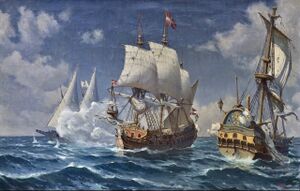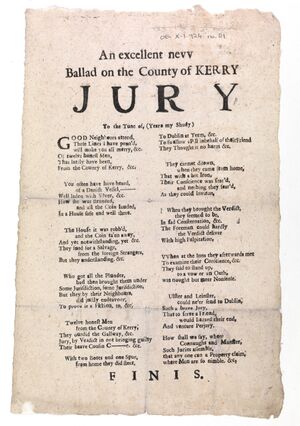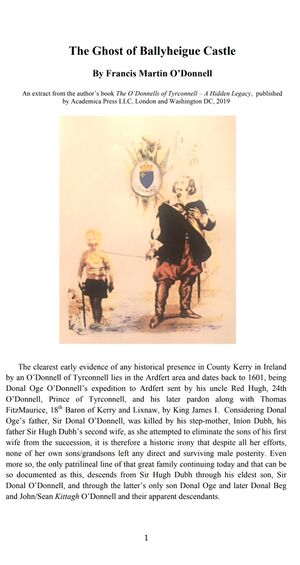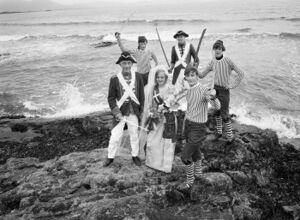Den Gyldne Løve
Den Gyldne Løve (også kalt Gyldenløve, Golden Lion, Golden Lyon, Den Gyldene Løve, etter dagens rettskriving Den Gylne Løve) var ein norsk-dansk fregatt [1][2] og «austindiafarar» bygd i Amsterdam i 1727[3]. Skipet var 96 fot og hadde eit mannskap på 88, tre dekk, tre master og 22 kanonar[4]. [5].
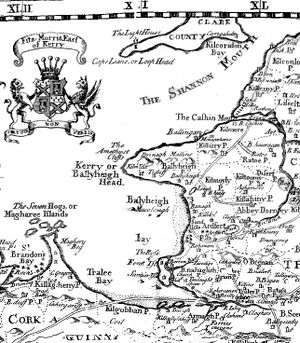
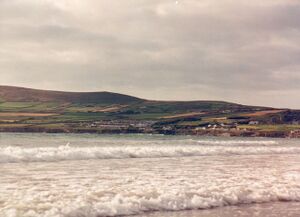
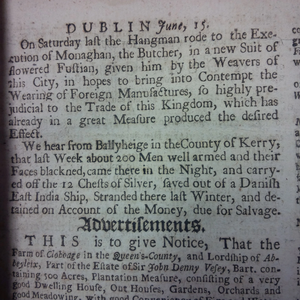
Den 66 år gamle Johan Heitmann var skipet sin kaptein på den andre seglasen til India, det som skulle vera første turen i teneste for Asiatisk Kompagni [7] til kolonien Trankebar (no Tharangambadi). Lasta var dyrebar, romma under dekk av fylte med 60 tonn med jern og kornvarer, men det mest verdifulle var 12 kister med sølv i myntar og sølvbarrar, for til saman 80.000 danske riksdalar eller £ 16.000 (tilsvarer £ 2,7 millionar [8] eller 33,6 millionar norske kroner[9] i januar 2023). Sølvet skulle vera med til den danske kolonien for å kjøpa varer, men truleg også for å sikra langsiktige avtalar med dei indiske landeigarane i området.
Den Gyldne Løve gjekk frå København 21. oktober 1730[10], nokre dagar før orlogsskipet Cronprintz Christian[11][12], som skulle etablera handel med Kanton og Kina. Cronprintz Christian kom fort ut for uvêr, og gjekk til Færøyane for naudhamn og reparasjonar. Etter det var ferda med dette skipet vellykka og gav grunnlag for vidare handel med Kina.
Den 8. november[13] (28. oktober etter britisk kalender) kom også Den Gyldne Løve inn i stormfullt vêr, ho var då utanfor County Kerry[14] på sørvestkysten av Irland. I loggboka[15] noterte styrmann Smidt at dei fekk tre varsel om at ferda kom til å enda ille: Først mista han noko av navigasjonsutstyret overbord, så drøymde ein av mannskapet at skipet kom til å gå på grunn, og tre dagar i førevegen viste det seg eit sterkt raudt lys over heile himmelen: saadant var mig aldri tilforn forekommet, mens Capitain Heithmand, fortalte, at hand eengang tilforn havde seet det, hvorefter nogle Dage kom en stærk storm. Når det først blei ropt "land i sikte" og "brenning forut", var dei overtydde om at det var "Eiland Brasil"[16], ei øy sjøfolk og kartmakarar på den tida meinte skullle ligga 50 mil utanfor kysten av Irland. Det gjorde at dei kan ha lagt kursen lengre aust, for å komma innom øya, noko som berre gjorde at dei endte opp rett mot irskekysten.
Stranda
Skipet stranda like ved landsbyen Ballyheige[17] (Bhaile Uí Thaidhg), etter at mannskapet med vilje sette det på grunn der, noko som blei eit poeng i seg sjølv i saka seinare. Den lokale godseigaren Thomas Crosbie sende tenarane sine ut for å komma kaptein Heitmann til unnsetning og stansa ei stor folkemengd som prøvde plyndra skipet. Han gav kapteinen og offiserane husly på Ballyheigue House, saman med den store og dyrebare lasta. Med dårleg helse etter å ha anstrengt seg for å redda mannskapet, døydde Crosbie kort tid seinare. Etter nokre månader innleidde enkja Lady Barrymore eit bergingskrav som endte med at ho blei tilkjent 4000 pund. Dramaet var likevel berre såvidt begynt !
Sølvet blir stole
Tidleg i juni 1731 tok hendingane ei spektakulær vending då Crosbie-eigedommen blei storma av minst 60 menn [18] som slapp unna med dei tolv sølvkistene og drap minst to danske vakter i prosessen. Sjølv om halvparten av sølvet blei henta inn att med hjelp av Francis Ryan, ein av leiarane i gjengen, er framleis mykje av verdiane borte den dag i dag.
Å finna dei ansvarlege for ranet blei ei langdryg affære som vekte oppsikt over heile Irland. Mistanken fall snart på Crosbie-familien og andre jordeigarar. Kaptein Heitmann var med rette bekymra over det nære forholdet mellom den lokale sorenskrivaren Sir Maurice Crosbie, ein nevø av den nyleg avdøde Thomas, og dei mistenkte, saman med Lady Barrymore sitt tvilsame bergingskrav. Han hadde ikkje noko særleg tillit til domstolen i County Kerry, og han ønska at saka skulle behandlast i Dublin. Saka opna til slutt i Dublin i november 1735 og endte i frifinning av Arthur Crosbie (fetter til Thomas), erkediakon Francis Lauder og kona hans Bridget. Slik kaptein Heitmann nok både ante og frykta, blei Lady Margaret aldri sikta for å vera involvert. Han vende endeleg tilbake til Danmark i 1740, 76 år gammal og døydde kort tid seinare.
Sidan har det vore sett eit gjenferd på slottet som ser ut som ein sjømann : Personen held eit sverd og er kledd i lange, tettsittande bukser (hoser) eller høge støvlar.[19] Sverdet røper at det kanskje heller er ein av dei to danske vaktene som blei drepne i storminga av slottet i 1731, som går igjen - om ein då skal tru på det overnaturlege.
Vrak eller ikkje vrak ?
Restane av vraket kan framleis ligga på stranda i Ballyheigue, men sidan det er så mange vrak i området, var det vanskeleg å vera heilt sikker på kva som er Den Gyldne Løve. Arkeologar undersøkte fleire vrak i september 2014, då det var ein periode med spesielt lågt tidevatn. [20][21] Etter vidare undersøkingar og tolking av funna, slo arkeologen Laurence Dunne[22] fast at Den Gyldne Løve ligg på stranda i Ballyheigue, på posisjonen 52° 23' 02.369" N, 09° 50' 01.102" W. [23] National Monuments Service skriv[24] likevel i 2020 om "det mystiske vraket på Ballyheigue Strand" at det ikkje er sikkert at det er Den Gyldne Løve. National Monuments Service meiner det berre er eitt vrak, men Dunne har funne to ulike vrak på nesten same staden. Det ser ut som han meiner dette ut frå at han har funne nokre jern-barrar [25] (iron ingots) eit stykke unna den andre vrakstaden, og det kan vera dette var ein del av lasta til Den Gyldne Løve.
Ting kan imidlertid tyda på at skipet var i så god stand at det var muleg å få det laus frå stranda og reparera skadane. I eit dokument frå den danske sida som oppsummerer verdiane som er gått tapt, viser dei til at Crosbie tok skipet og "and brought it at sea again and promised to pay therefor."[26][27]
Munnleg overlevering
Historia om Den Gyldne Løve er munnleg overlevert i Ballyheigue heilt fram til vår tid. I ein skulestil[28] har Éibhlís Ní Argáin skrive ned den versjonen som no blir fortalt blant dei gamle i landsbyen :
"They overcame them, took the silver and put the boxes on carts, which they had brought with them and some time afterwards divided it amongst the crowd, giving, it is said one-third to the Butler, one-third to Lady Margaret, and the remaining third to those who helped to uproot it from beneath the tower. This almost led to war between the Irish and Danes later. The Danes asked the English to help them to get back their silver but, it is said they took no steps to do so."
"The story of the silver ship is told up to the present day and some of the silver vessels which were found in it, are still to be found in the Castle."
Litt fleire detaljar finn vi i attforteljinga i Eric Wood si bok "The Boy’s Book of the Sea"[29], sjølv om noko av det som står der kan vera dikting.
Nyare fenomen
Vidare har historia vore opphavet til ulike festivalar, paradar og liknande i nyare tid. I 1967 og 1968 blei det arrangert Ballyheigue Golden Lion Festival [30] med "fancy dress pageant", ei slags kostymeoppvising med premiering av "Golden Lion Queen". I 2017 var det ein kveld "The Golden Lion Show Case Night of Entertainment"[31]. Truleg har det vore fleire slike med meir eller mindre historiske innslag.
Referansar
- ↑ https://no.wikipedia.org/wiki/Fregatt#De_første_«sanne_fregatter» Fregatten som skipstype i 1730
- ↑ http://www.irishwrecksonline.net/Lists/KerryList.htm Irishwrecksonline Wrecks off Co. Kerry: The Golden Lion notert som "Danish East India Frigate"
- ↑ https://slaegtsbibliotek.dk/923725.pdf Magnus, Hein 1980. Johan Hansøn Heitman - 1664-1740 - en norsk skipper, kartograf og skribent (Johan Hansøn Heitman, Norwegian Sea Captain, Cartographer and Writer), s 80-88 i: Handels- og Søfartsmuseet på Kronborg årbog 1980
- ↑ https://www.nb.no/items/815df0c5c310dd7a153ac37edfe8d3da?page=47 Annotert bibliografi over Johan Hanssøn Heitmann : med en kort biografi, Juvik 1999
- ↑ https://en.m.wikipedia.org/wiki/Russian_frigate_Shtandart Den russiske fregatten Shtandart liknar i mål og utforming på Den Gyldne Løve
- ↑ https://en.wikipedia.org/wiki/Charles_Smith_(topographer) Charles Smith, lokalhistorisk forfattar
- ↑ http://ribewiki.dk/da/Gyldne_Løve_1730_Vestirland RibeWiki om skipet Den Gyldne Løve, forliset og etterspelet, ny side oppretta på VragWiki: https://vragwiki.dk/wiki/Gyldne_Løve_1730_Vestirland
- ↑ https://www.bankofengland.co.uk/monetary-policy/inflation/inflation-calculator Omrekningskalkulator for engelske pund
- ↑ https://www.dnb.no/markets/valuta-og-renter/valutakalkulator Valutakalkulator
- ↑ http://www5.kb.dk/manus/vmanus/2011/dec/ha/object410619/da#kbOSD-0=page:493 Niels Smidt 1730. Journal ført på 6 rejser til Trankebar 1718-1730 ombord på "Jomfru Susanna" ("Dronning Anna Sophia") og "Den gyldne Løve" af styrmanden Smidt
- ↑ https://slaegtsbibliotek.dk/923504.pdf Den danske Ostindie- og Kinahandel, Knud Klem, i: Handels- og Søfartsmuseet Aarbog 1943, s 81
- ↑ https://en.wikipedia.org/wiki/Cron_Printz_Christian_(DAC_ship) CronPrintz Christian
- ↑ https://www.tcd.ie/library/manuscripts/blog/2015/02/the-golden-lion-and-its-silver-swag-a-kerry-tale-of-adventure/ Trinity College Dublin, 2015: The Golden Lion and its silver swag: a Kerry tale of adventure.
- ↑ https://en.wikipedia.org/wiki/County_Kerry County Kerry
- ↑ http://www5.kb.dk/manus/vmanus/2011/dec/ha/object410619/da#kbOSD-0=page:493 Niels Smidt 1730. Journal ført på 6 rejser til Trankebar 1718-1730 ombord på "Jomfru Susanna" ("Dronning Anna Sophia") og "Den gyldne Løve" af styrmanden Smidt
- ↑ https://no.wikipedia.org/wiki/Brasil_(mytisk_øy) Den mytiske øya Brasil
- ↑ https://en.wikipedia.org/wiki/Ballyheigue Ballyheige
- ↑ https://www.tcd.ie/library/manuscripts/blog/2015/02/the-golden-lion-and-its-silver-swag-a-kerry-tale-of-adventure/ Pue’s Occurrences, June 1731, reports ‘about 200 men’ were involved in the raid. Shelf mark: IN.18.42. Pue’s Occurrences, June 1731, Coláiste na Tríonóide, Baile Átha Cliath, Trinity College Library, Dublin, i Trinity College Dublin, 2015: The Golden Lion and its silver swag: a Kerry tale of adventure.
- ↑ https://www.mysteriousbritain.co.uk/hauntings/ballyheigue-castle/ "The figure held a sword and appeared to be clad in hose or thigh boots." A ghost and hidden treasure associated with Ballyheigue Castle, Mysterious Britain & Ireland, 2013/2018
- ↑ https://www.independent.ie/regionals/kerryman/news/low-tides-allow-rare-shipwreck-study-30592941.html Low tides allow rare shipwreck study, The Kerryman 17. september 2014
- ↑ https://www.facebook.com/media/set/?set=a.787798784601160&type=3&comment_id=817803468267358 Laurence Dunne Archaeology's albums: 17th century shipwreck exposed in Ballyheigue Bay, sjå fotnote I under
- ↑ https://www.linkedin.com/in/laurencedunnearchaeology/?originalSubdomain=ie Laurence Dunne, Senior Archaeologist
- ↑ https://epawebapp.epa.ie/licences/lic_eDMS/090151b28052b2b0.pdf Underwater Archaeological Impact Assessment, Proposed Dumpsite, Tralee Bay, Co. Kerry. Laurence Dunne Archaeology, 17. oktober 2014
- ↑ https://www.facebook.com/NationalMons/posts/pfbid0CbqavXyowSKkrWgDynmvqvnhgNvButjbJkN3YDZF6E8D5iNi9YdRPqL8M7UaYBA1l Innlegg på Facebook-sida "National Monuments Service - Archaeology": Wreck of the Week - The Mysterious Wreck on Ballyheigue Strand, Co. Kerry., National Monuments Service, Dept. of Housing, Local Government & Heritage 18. august 2020, sjå fotnote II under
- ↑ https://dahg.maps.arcgis.com/apps/webappviewer/index.html?id=89e50518e5f4437abfa6284ff39fd640&query=Wrecks_April_2018_7147,Wreck_No,W11164 National Monuments Service: Wreck Viewer, National Monuments, Underwater Archaeology, 2018. Wreck: Unknown, Wreck Name Unknown, Wreck Number W11164, Classification Unknown, Place of Loss Ballyheigue Beach, NW of Tralee, Date of Loss Unknown, DD Latitude 52,38368, DD Longitude -9,83408, Source of Co-ordinate Laurence Dunne, Description Iron ingots become exposed on the beach when sand levels are low indicating the location of a wreck, Record Source Laurence Dunne, short URL https://bit.ly/3fOX0BB
- ↑ https://tidsskrift.dk/mfs_aarbog/article/view/96484/145331 O'Rourke, Andrew 1996. Captain Johan Heitman, DEN GYLDNE LØVE and the Danish Silver Robbery (Kaptajn Johan Heitman, DEN GYLDNE LØVE og røveriet af det danske sølv), s 50-85 i: Handels- og Søfartsmuseet på Kronborg årbog 1996, sjå s 72
- ↑ Instructions to and reports from von Johnn are in Rigsarkivet TKUA 246 (XI11) and TKUA 93-95.
- ↑ https://www.duchas.ie/en/cbes/4678380/4673773/4682081 Argáin, Éibhlís Ní, ukjent år. The Schools’ Collection, Volume 0417, Gender: female, Address: Ballinclemesig, Co. Kerry, School: Bouleenshere (C.)(roll number 12865), Location: Booleenshare, Co. Kerry, Teacher: Mary A. Walsh, side 364ff
- ↑ https://www.gutenberg.org/files/67614/67614-h/67614-h.htm#Page_285 Eric Wood 1915: The Boy’s Book of the Sea, s 285ff, The Gutenberg Project eBook Release Date: March 12, 2022, på https://www.biblio.com/book/boys-book-sea-wood-eric/d/111830377 : "Keywords Young Adult, Sea Stories, Juvenile Fiction
- ↑ https://www.kennellyarchive.com/id/NVL030/ Kennelly Archives 1967 Ballyheigue Golden Lion Festival
- ↑ https://www.facebook.com/profile/100064814946549/search/?q=Golden%20Lion Ballyheigue Community Centre, november 2017: "The Golden Lion Show Case Night of Entertainment fundraising variety concert in aid of Ballyheigue Community Centre"
Litteratur og kjelder
- Dungan, Myles 2015. On this day – 12 June 1730 – The robbery of the Golden Lion in Ballyheigue, Co.Kerry., 12.06.2015
- Dungan, Myles / irishhistory 2015. 12th June 1730 - The theft of the silver bullion from the Golden Lion, podcast om sølvskatten frå Den Gyldne Løve
- Holzer, Hans, 1967. The Lively Ghosts of Ireland, London 1967, side 32, refererer til artikkel frå 1962 av Patrick Denis O'Donnell i Ireland of the Welcomes.
- Kennelly Archives 1966. October 1966; pottery dig with mugs found near a shipwreck in Ballyheigue, Pat and Des Lavelle, Jerry and Padraig Kennelly Junior, the Evans family,
short URL: https://bit.ly/313eCWb - MacMahon, Bryan 1991. New Light on The Golden Lion and the Danish Silver Robbery at Ballyheigue, i: Journal of the Kerry Archaeological and Historical Society. Vol: 24 pp:113-149, 1991.
Utdrag: This article examines the robbery in 1731 of six chests of silver, part of the cargo of the 'Golden Lion' which was driven ashore at Ballyheigue during the previous year. - MacMahon, Bryan 1994. The Story of Ballyheigue, Ballyheigue, 1994 ISBN 0-9517658-2-5
- O'Donnell, Francis Martin, 2019.The Ghost of Ballyheigue Castle. An extract (4 pages) from the book The O’Donnells of Tyrconnell – A Hidden Legacy, by Francis Martin O'Donnell, published by Academica Press LLC, London and Washington DC, 2019.
- RadioKerry FM, Tralee, 25. desember 2020, artikkel 900 - The Story of Kerry Shipwrecks, plasserer det ukjente vraket på "Ballyheigue Strand, 310m SW of Ballyheigue carpark"
- RadioKerry FM, Tralee, 25. desember 2020, lydklipp#1 Helen O’Carroll, curator of the County Museum, describes what artefacts they have from this wreck
- RadioKerry FM, Tralee, 25. desember 2020, lydklipp#2 Local historian Brian McMahon, tells us more about The Golden Lion
- Rigsarkivet, København, Arkivfunktionen for samlinger af kopier dannet af Rigsarkivet (1730-1784). Arkivserie: D-film nr. 24: Dokumenter i British Museum vedr. Dansk Handel i fjernøsten (1730 - 1786) Seddelregistratur 3, nr. 24, Bemærkninger: Mikrofilm. Indeholder to manuskripter fra British Museum. 1) Beretning ang. skibet "Gyldne Løve"'s stranding i Irland (1730). 2) Rapport ang. officielle danske klager over told (1786). Udskilt fra Filmsamling D.
- The Crosbie Papers, Letters and papers relating to the Danish Silver Robbery, 1731-1735, i "Talbot Crosbie Papers", tidlegare referert til NLI MS 5033, rett referanse er : Call Number: MS 50,545/12 (Manuscripts Reading Room), Collection: Talbot Crosbie Papers. XII. Letters and papers relating to the Danish Silver Robbery, 1731-1735. Notes: Papers relating to the robbery of the cargo of the Golden Lyon from the property of Thomas Crosbie in 1731. Physical description: 6 folders (c.70 items), Leabharlann Náisiúnta na hÉireann / National Library of Ireland, Baile Átha Cliath / Dublin
- The Irish Times, 31. januar 2005 10,000 shipwrecks listed off coast, "Vi skal no begynna å undersøkja funnstadene", seier Mr Fionnbarr Moore, senior arkeolog ved Avd for undervassarkeologi ved The National Monuments Service. Moore skal prøva finna ut om to vrak som har dukka opp ved lågvatn dei siste vekene på Banna Strand, Co. Kerry, kan vera av store handelsskip som forsvann tidleg på 1700-talet.
- Titley, Walter: Titley Papers - By Walter Titley, British Resident Minister at the Court of Denmark. Referert hos Foreningen Trankebar, linken er daud per 7. mars 2023: http://www.trankebar.net/history/golden-lion/titley.htm
Fotnotar
I.
17th century shipwreck exposed in Ballyheigue Bay
... In 1987 the National Monuments Act was amended and since then it is illegal to remove or interfere with shipwrecks that are over 100 years old without a licence from the National Monuments Service.
Our current research show that around 238 shipwrecks occurred between Brandon Point, Kerryhead and Tralee. Of that total there are around 26 recorded shipwrecks in Ballyheigue alone with another 9 at Kerryhead, five on Banna Beach and 10 at Barrow. In the overall Tralee Bay area there is an amazing total of 181 shipwrecks recorded so far. ... Bad weather aside, a major contributory factor to the large number of shipwrecks during the age of sail was due to poor navigation as there were virtually no accurate sea charts completed until the 19th century. ... Tralee Bay is an extremely dangerous bay to be in a storm and was even more so in the age of sail. The bay is shallow and has many islands, reefs and rocks. The earliest description of Tralee Bay was recorded by Charles Smith in 1756 and who also provided a map. Smith writes...’The east side is a flat, low land, called Magheriebeg, off which are 7 small islands called the Hogs...By giving the Hog Islands a berth, and sailing east by north you come into Tralee Bay, little frequented by ships, being dry at low water; however small vessels lie safe aground in it. The channel is towards the middle of the bay, the entrance is between two small islands, called the Sampier Isles to the north, and the mainland to the south. All the maps of Ireland and sea charts place Fenit Island, which they call Fenor, in the middle of this bay, whereas it lies close to the shore on the north side, between which and the main there is a small creek for ships, which must be entered from the north, but the passage is so narrow and foul, that it cannot be entered without a good pilot.’
A number of ships wrecked, including the Wind Trader, were East Indiamen. These were very large three masted and three decked armed cargo ships operated from the Baltic and Netherlands trading between major ports like Bristol and Liverpool to the East Indies and to the Americas....
Laurence Dunne Archaeology's albums: 17th century shipwreck exposed in Ballyheigue Bay, Facebook 19. november 2014.
https://www.facebook.com/media/set/?set=a.787798784601160&type=3&comment_id=817803468267358
II.
Wreck of the Week - The Mysterious Wreck on Ballyheigue Strand, Co. Kerry.
When the tide is out at Ballyheigue and when stormy seas shift the soft sands, the skeletal remains of a wreck become visible on the lower strand. The wooden ribs and mound of ballast stones hint at what was once a medium-sized sailing ship. In the past, during periods of bad weather, some of the buried cargo became strewn across the beach. Broken pottery, glass bottles and pieces of wooden barrels have been recovered over the years by people walking the beach. These finds, along with material recovered from targeted investigations of the wreck, suggest the vessel was an 18th century trading ship.
The ship would have been subject to extensive salvage efforts after being stranded on an accessible beach, with locals invoking the age-old right to ‘spoils of the sea’. Images from the 1960s which form part of the Padraig Kennelly Archive, show local interest as well as curiosity in the wreck at that time. Investigations of the wreck in the 1960’s by Kerry historian Edward Roe, recovered a large amount of ceramics, intact glass wine and brandy bottles, along with three felt tricorne hats packed in straw within a crate. Mr Roe donated his collection to Kerry County Museum, where they are housed today along with his archive of historical material which he bestowed to Kerry County Library in Tralee. A human upper arm bone was also recovered from the site (Murray, G. & Ní Mhurchú, C. 2011) which lends further significance to the wreck as the potential final resting place for members of possible passengers or crew.
The wreck and associated artefacts are protected under the National Monuments Act, and in September 2014, following a report of recent interference, the National Monuments Service’s Underwater Archaeology Unit undertook a targeted excavation to assess the damage. The freshly broken remains of a barrel and glass bottles were identified, as was a scatter of 18th century ceramics including Westerwald, Sgraffito and Staffordshire cream ware. Packing material used between the barrels and crates within the hold of the ship -known as dunnage- was also recovered.
The identity of the wreck remains a mystery. The National Monuments Service’s Wreck Inventory of Ireland Database (WIID) lists some 20 wrecks for the Ballyheigue/Tralee Bay area, from the 17th - through to the 19th centuries. Local tradition does point to two ships as the most likely candidates. The ‘Golden Lion’ or ‘Gyldenlove’, a Danish East India frigate which was en route from Copenhagen to Tranquebar (now Tharangambadi, India), became stranded on the beach at Ballyheigue in 1730. Although the silver and gold on board was removed, the wreck is still the most popularly remembered and cited, probably due to its valuable cargo. ...
Innlegg på Facebook-sida "National Monuments Service - Archaeology": Wreck of the Week - The Mysterious Wreck on Ballyheigue Strand, Co. Kerry., National Monuments Service, Dept. of Housing, Local Government & Heritage 18. august 2020 nationalmonuments@housing.gov.ie archaeology.ie
https://www.facebook.com/NationalMons/posts/pfbid0CbqavXyowSKkrWgDynmvqvnhgNvButjbJkN3YDZF6E8D5iNi9YdRPqL8M7UaYBA1l
III.
...the Danish East Indiaman, the Golden Lyon, which, with twelve chests of silver bullion and coin totalling £15,966 9s' 6d., was driven ashore in Ballyheigue Bay in 1730. Ballyheigue House was then a 'long, low, thatched mansion of the old-fashioned Irish type.' In the south-west corner of the court-yard there was a strong stone tower, with vaults and a cave beneath it, ...
Hickson, Old Kerry Records, 2nd Series, s 283-284 i: The Irish Ecclesiastical Record, 1921, henta frå Internet Archive :
https://archive.org/stream/5sp2irishecclesi18dubluoft/5sp2irishecclesi18dubluoft_djvu.txt
